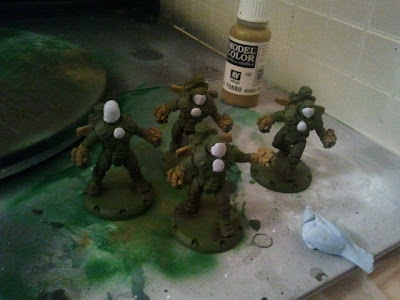I usually avoid painting and modelling hobby forums like the plague, but I like the people over on Fantasy Flight. I had forgotten how much until I posted the link to part 1 over on the modelling section of 'Dust Tactics'.
ZuggZugg and Psykostevo were kind enough to have a look, then take the time to share their thoughts. We are all of us agreed that this painting article about airbushing has really been co-opted by my unhealthy proclivity for weathering.
And now?
Some weathering, (and other stuff).
Step 1: Rusty bits!!!!
I splash a thin layer of MIG Rust Effects onto the patchy brown areas from the previous article. I allowed it to dry, (for more than the 15 minutes recommended on the bottle) then applied a second coat. I don't want them to look too beaten up, just enough to show that they're fighting a war at close quarters so that's enough MIG for now :(
 |
| MIG rust effects. Liquid crack for weathering fanatics. |
I used Vallejo Carmine Red, Yellow Olive and Medium Fleshtone in various combinations. There isn't much skin on these units, so it doesn't take long!
 |
| Colours for the skin |
 |
| Not a great picture |
 |
| A slightly more healthy look. If you're very, very ill. |
 |
| Skin's more or less done. |
The metal and armour areas are washed in a thin layer of GW Badab Black wash. I find that this ties the colours together nicely in a dark scheme as well as making weathering and decals look more natural.
 |
| Just been washed with Badab Black. |
I apply a thin layer of Vallejo Brown Earth to the base with an old brush, taking care to apply only a small amount to the soles of the models boots and slightly around the edges. My goal is to simulate the mucky slush that results from a large, heavily armoured warrior trudging around in it.
Snow is only truly white on Christmas cards.
 |
| It's brown. It's earth. It's....Brown Earth... |
The circumference of each base was painted with GW Astronomican Grey foundation paint.
Step 6: Rhino's quiff (and eye patch)
Rhino is the only one of the models in this article with hair, so he gets his own section in the post.
I applied a couple of thin layers of Olive Drab as a basecoat; gradually mixing adding and blending Flat Earth up to Khaki Grey, (all pictured).
I focussed the extreme highlights on his quiff and above the sideburns. I was basing him on Marvel's Nick Fury.
The finished article:
 |
| Done. |
Step 6: Rhino's quiff (and eye patch)
Rhino is the only one of the models in this article with hair, so he gets his own section in the post.
I applied a couple of thin layers of Olive Drab as a basecoat; gradually mixing adding and blending Flat Earth up to Khaki Grey, (all pictured).
I focussed the extreme highlights on his quiff and above the sideburns. I was basing him on Marvel's Nick Fury.
 |
| Makes Nick Fury look like Nick 'slightly peeved' |
 |
| I need an alternative to my camera phone... |
I hope this was useful to somebody. The airbrush is a great hobby tool, but ZuggZugg was onto something when he asked if my weathering was masking the true effect. The answer is yes, to some extent. The main problem is the quality of my pictures. The airbrush highlights have given the armour a really authentic look to the naked eye and I'll certainly be repeating it with my other armoured infantry.
That is once I've finished the onerous task of adding brown earth and snow to the entire contents of the original Dust Tactics boxed set.
I knew I should have based them properly as I went :(
Thanks for reading.










